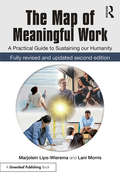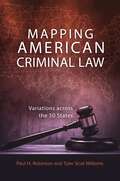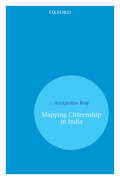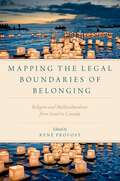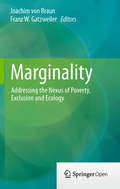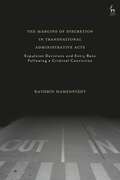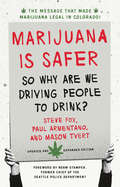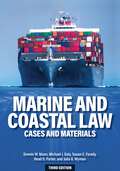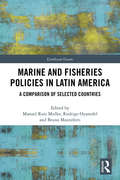- Table View
- List View
The Map of Meaningful Work (2e): A Practical Guide to Sustaining our Humanity
by Marjolein Lips-Wiersma Lani MorrisThis book introduces the Map of Meaning which provides a clear, simple and profound framework of the dimensions and process of living and working meaningfully. The Map of Meaning is based on over 20 years' research into the insights and practice of ordinary people as they search for, lose and find meaning. Incorporating the ideas of philosophers, psychologists and sociologists, this book describes how human beings wrestle with, and answer, questions such as, "What gives my life and work meaning?", "How can I balance inspiration and reality and maintain positive momentum?" and "How do we integrate meaningfulness into our workplaces?". Innate human knowledge is captured in a practical model that makes understanding and working with issues of meaning clear and accessible to everyone. At an individual level this book helps people to define and stay in contact with what is most important to them as they grapple with the real problems of daily life. It shows how they can stay in charge of keeping the human search for meaning alive, especially in the face of the challenges that exist in organizational life. Because the dimensions of meaning are shared, the second half of the book focuses on how we can bring an awareness of what creates meaningful work into our thinking about the practice and design of organisations. The authors recognize that in the current economic context a simple, yet profound guide for humanity is essential, precisely because organizational life has become so intensely directed towards a singular economic goal. They argue that it is vital that people have an easy, powerful way to reclaim the significance of meaning in their working lives both individually and at a whole of organization level. Updated with new chapter material and case studies, this second edition offers profound insights for anyone who is interested in creating more meaning and purpose in work and organizations – from a CEO to a blue-collar worker or consultant. It is for those searching for ways to re-energize their roles or change their careers. It is for anyone who firmly believes that it must be possible to align our deeper life purposes with our daily actions in the workplace. It is for anyone who is committed to creating workplaces that support and enable the experience of work that feels worth doing.
Mapping American Criminal Law: Variations across the 50 States
by Paul H. Robinson Tyler Scot WilliamsContaining 40 visually coded maps of the fifty states, this book offers an unprecedented look at America's diverse legal landscape.This first-of-its-kind volume sketches the diversity implicit in United States criminal law doctrine through its examination of a range of criminal laws pertaining to murder, sexual assault, drug offenses, the insanity defense, and more and the way in which different states deal with those issues. In addition to providing insights into the most widely invoked standards in criminal law, it raises awareness of the enormous discrepancies among the criminal laws of states, documenting them using dozens of visually coded maps that showcase geographic, political, and socioeconomic differences to explain patterns of agreement and disagreement. Mapping American Criminal Law: Variations Across the 50 States is for political scientists, criminologists, sociologists, legal scholars, policy advisors, legislators, lawyers, judges, and scholars and students of these fields. In addition, each chapter is highly accessible to laypersons and includes an explanation of the subject matter as well as explanations of the various approaches to criminal law taken by states.
Mapping American Criminal Law: Variations across the 50 States
by Paul H. Robinson Tyler Scot WilliamsContaining 40 visually coded maps of the fifty states, this book offers an unprecedented look at America's diverse legal landscape.This first-of-its-kind volume sketches the diversity implicit in United States criminal law doctrine through its examination of a range of criminal laws pertaining to murder, sexual assault, drug offenses, the insanity defense, and more and the way in which different states deal with those issues. In addition to providing insights into the most widely invoked standards in criminal law, it raises awareness of the enormous discrepancies among the criminal laws of states, documenting them using dozens of visually coded maps that showcase geographic, political, and socioeconomic differences to explain patterns of agreement and disagreement. Mapping American Criminal Law: Variations Across the 50 States is for political scientists, criminologists, sociologists, legal scholars, policy advisors, legislators, lawyers, judges, and scholars and students of these fields. In addition, each chapter is highly accessible to laypersons and includes an explanation of the subject matter as well as explanations of the various approaches to criminal law taken by states.
Mapping Citizenship in India
by Anupama RoyContributing to the ongoing debates on citizenship, this book traces the Citizenship Act of India, 1955 from its inception, through the various amendments in 1986, 2003, and 2005. It includes detailed studies of other significant laws and judgments including the Abducted Persons (Recovery and Rehabilitation) Act (1949), and the Illegal Migrants Determination by Tribunals Act (1983) to show how citizenship unfolded among differentially located individuals, communities, and groups. The book argues that the citizenship laws in India show a steady movement towards the affirmation of citizenship's relationship with blood-ties and descent. The volume identifies amendments in the Citizenship Act as transitions which are framed by major historical choices and decisions. It examines the liminal categories of citizenship produced in the period between the commencement of the Constitution and the enactment of the Citizenship Act, which continue to make citizenship fraught with uncertainties and exclusions. Through a discussion of laws and judgments, the work also brings out the relationship between citizenship and migration in independent India, in particular in the wake of migration from Bangladesh and distress migration because of the breakdown of rural economies.
Mapping Global Justice: Perspectives, Cases and Practice (Global Issues in Crime and Justice)
by Arnaud Kurze Christopher K. LamontPersistent international conflicts, increasing inequality in many regions or the world, and acute environmental and climate-related threats to humanity call for a better understanding of the processes, actors and tools available to face the challenges of achieving global justice. This book offers a broad and multidisciplinary survey of global justice, bridging the gap between theory and practice by connecting conceptual frameworks with a panoply of case studies and an in-depth discussion of practical challenges. Connecting these critical aspects to larger moral and ethical debates is essential for thinking about large, abstract ideas and applying them directly to specific contexts. Core content includes: Key debates in global justice from across philosophy, postcolonial studies, political science, sociology and criminology The origins of global justice and the development of the human rights agenda; peacekeeping and post-conflict studies Global poverty and sustainable development Global security and transnational crime Environmental justice, public health and well-being Rather than providing a blueprint for the practice of global justice, this text problematizes efforts to cope with many justice related issues. The pedagogical approach is designed to map the difficulties that exist between theory and praxis, encourage critical thinking and fuel debates to help seek alternative solutions. Bringing together perspectives from a wealth of disciplines, this book is essential reading for courses on global justice across criminology, sociology, political science, anthropology, philosophy and law.
Mapping Global Justice: Perspectives, Cases and Practice (Global Issues in Crime and Justice)
by Arnaud Kurze Christopher K. LamontPersistent international conflicts, increasing inequality in many regions or the world, and acute environmental and climate-related threats to humanity call for a better understanding of the processes, actors and tools available to face the challenges of achieving global justice. This book offers a broad and multidisciplinary survey of global justice, bridging the gap between theory and practice by connecting conceptual frameworks with a panoply of case studies and an in-depth discussion of practical challenges. Connecting these critical aspects to larger moral and ethical debates is essential for thinking about large, abstract ideas and applying them directly to specific contexts. Core content includes: Key debates in global justice from across philosophy, postcolonial studies, political science, sociology and criminology The origins of global justice and the development of the human rights agenda; peacekeeping and post-conflict studies Global poverty and sustainable development Global security and transnational crime Environmental justice, public health and well-being Rather than providing a blueprint for the practice of global justice, this text problematizes efforts to cope with many justice related issues. The pedagogical approach is designed to map the difficulties that exist between theory and praxis, encourage critical thinking and fuel debates to help seek alternative solutions. Bringing together perspectives from a wealth of disciplines, this book is essential reading for courses on global justice across criminology, sociology, political science, anthropology, philosophy and law.
Mapping Legal Innovation: Trends and Perspectives
by Antoine Masson Gavin RobinsonThe legal sector is being hit by profound economic and technological changes (digitalization, open data, blockchain, artificial intelligence ...) forcing law firms and legal departments to become ever more creative in order to demonstrate their added value. To help lawyers meet this challenge, this book draws on the perspectives of lawyers and creative specialists to analyze the concept and life cycle of legal innovations, techniques and services, whether related to legislation, legal engineering, legal services, or legal strategies, as well as the role of law as a source of creativity and interdisciplinary collaboration.
Mapping the Journey: Case Studies in Strategy and Action toward Sustainable Development
by Lorinda R. Rowledge Russell Barton Kevin Brady James Fava Cynthia Figge Konrad Saur Steven YoungThis illuminating new book presents a series of in-depth case studies from around the world based on numerous personal interviews with organizational leaders and focusing on their journey towards sustainability. The aim is to provide visions of a more sustainable future, and shed light on the path, milestones and solutions – in particular the management processes these organizations employed – to provide a reliable compass that others can follow. Although each organization must take steps to fit its particular circumstance, business conditions and culture, Mapping the Journey proves that valuable lessons can be learned by setting aside critique as to where these organizations may yet make progress and instead focusing on the guidelines, targets, measures of success, tools and techniques and valuable wisdom about how pioneer organisations are travelling toward a prosperous, sustainable future. Each organization included has crafted its own unique strategic responses to an identified need for increased sustainability. While none can be said to have reached the end-point of a sustainable development strategy, all have found that, by addressing the challenge of sustainable industrial practices, they have found innovative solutions, new opportunities for revenue generation, better relationships with customers, new business and product opportunities and a boost to morale from the executive ranks to front-line employees. Mapping the Journey examines both public and private organizations worldwide: SJ Rail of Sweden; Sony Corporation; SC Johnson; TransAlta Corporation; Patagonia; Henkel; Volvo; ASG; Interface Flooring Systems; Suncor; DaimlerChrysler; AssiDoman; Germany's Centre for Technology Assessment and the Dutch National Environmental Policy Plan. These case studies provide an inspiring framework of effective processes for defining a sustainable development strategy and transforming it successfully into actions and results.
Mapping the Journey: Case Studies in Strategy and Action toward Sustainable Development
by Lorinda R. Rowledge Russell Barton Kevin Brady James Fava Cynthia Figge Konrad Saur Steven YoungThis illuminating new book presents a series of in-depth case studies from around the world based on numerous personal interviews with organizational leaders and focusing on their journey towards sustainability. The aim is to provide visions of a more sustainable future, and shed light on the path, milestones and solutions – in particular the management processes these organizations employed – to provide a reliable compass that others can follow. Although each organization must take steps to fit its particular circumstance, business conditions and culture, Mapping the Journey proves that valuable lessons can be learned by setting aside critique as to where these organizations may yet make progress and instead focusing on the guidelines, targets, measures of success, tools and techniques and valuable wisdom about how pioneer organisations are travelling toward a prosperous, sustainable future. Each organization included has crafted its own unique strategic responses to an identified need for increased sustainability. While none can be said to have reached the end-point of a sustainable development strategy, all have found that, by addressing the challenge of sustainable industrial practices, they have found innovative solutions, new opportunities for revenue generation, better relationships with customers, new business and product opportunities and a boost to morale from the executive ranks to front-line employees. Mapping the Journey examines both public and private organizations worldwide: SJ Rail of Sweden; Sony Corporation; SC Johnson; TransAlta Corporation; Patagonia; Henkel; Volvo; ASG; Interface Flooring Systems; Suncor; DaimlerChrysler; AssiDoman; Germany's Centre for Technology Assessment and the Dutch National Environmental Policy Plan. These case studies provide an inspiring framework of effective processes for defining a sustainable development strategy and transforming it successfully into actions and results.
Mapping the Legal Boundaries of Belonging: Religion and Multiculturalism from Israel to Canada (Religion and Global Politics)
For several decades, culture played a central role in challenging the liberal tradition. More recently however, religion has re-emerged as one of the central challenges facing Western liberal societies' conception of multiculturalism. Mapping the Legal Boundaries of Belonging explores the complex relationship between religion and multiculturalism and the role of the state and law in the creation of boundaries. The intersection between religion, nationalism and other vectors of difference in Canada and Israel offer an ideal laboratory in which to examine multiculturalism in particular and the governance of diversity in general. The contributors to this volume investigate concepts of religious difference and diversity and the ways in which these two states and legal systems understand and respond to them. As a consequence of a purportedly secular human rights perspective, they show, state laws may appear to define religious identity in a way that contradicts the definition found within a particular religion. Both state and religion make the same mistake if they take a court decision that emphasizes individual belief and practice as effecting a direct modification of a religious norm: the court lacks the power to change the authoritative internal definition of who belongs to a particular faith. Similarly, in the pursuit of a particular model of social diversity, the state may adopt policies that imply a particular private/public distinction foreign to some religious traditions.
Maqasid al-Shari’a and Contemporary Reformist Muslim Thought: An Examination
by Adis DuderijaIt is the first study which comprehensively, systematically and critically examines the role and usefulness of the concept of Maqasid al-Shari'a (higher Objectives of Islamic Law) in contemporary Muslim reformist thought in relation to number of specific issues pertaining to Islamic legal philosophy, law, ethics and the socio-political sphere.
MARE-WINT: New Materials and Reliability in Offshore Wind Turbine Technology
by Wiesław Ostachowicz Malcolm McGugan Jens-Uwe Schröder-Hinrichs Marcin LuczakThis book provides a holistic, interdisciplinary overview of offshore wind energy, and is a must-read for advanced researchers. Topics, from the design and analysis of future turbines, to the decommissioning of wind farms, are covered. The scope of the work ranges from analytical, numerical and experimental advancements in structural and fluid mechanics, to novel developments in risk, safety & reliability engineering for offshore wind.The core objective of the current work is to make offshore wind energy more competitive, by improving the reliability, and operations and maintenance (O&M) strategies of wind turbines. The research was carried out under the auspices of the EU-funded project, MARE-WINT. The project provided a unique opportunity for a group of researchers to work closely together, undergo multidisciplinary doctoral training, and conduct research in the area of offshore wind energy generation. Contributions from expert, external authors are also included, and the complete work seeks to bridge the gap between research and a rapidly-evolving industry.
Marek Thee: A Journey through the 20th Century (SpringerBriefs on Pioneers in Science and Practice #32)
by Marek Thee Nils Petter Gleditsch Stein Tønnesson Marta Bivand ErdalMarek Thee was a Jewish Polish journalist, scholar, and activist. This book tells his life from narrowly escaping death in the Holocaust to exile in Palestine, where he became attached to the Polish consular service. On his return to Poland in 1950, he worked for the Foreign Ministry and later for the Polish Institute for International Affairs. He served as Head of the Polish delegation to the International Control Commission in Indochina in the late 1950s. In 1968 he lost his job and his Polish citizenship in a nationalistic and antisemitic campaign. He was able to move to Norway where he worked for twenty years at the Peace Research Institute Oslo (PRIO), editing an international quarterly journal, Bulletin of Peace Proposals and doing research on the arms race. In retirement, he continued his research and writing at the Norwegian Human Rights Institute. The book vividly relates the drama of his life in Poland, Palestine, Indochina, and Norway.This is an open access book.
Margin Squeeze in the Electronic Communications Sector
by Anna Renata PisarkiewiczMargin squeeze is a form of abuse of a dominant position in which a vertically integrated company reduces the margin between the price charged to competitors and the price charged to consumers, which can have the effect of excluding a competitor from the market. In the decade or so since the liberalisation of network industries, margin squeeze has become a major source of concern among competition authorities and courts, particularly pronounced in the electronic communications sector. Because some of the adopted decisions show significant inconsistencies in approach, and legal certainty remains elusive in this area, this book which provides an extremely thorough analysis is both timely and of great practical value. The author provides an in-depth examination of margin squeeze allegations in the electronic communications sector with a view to developing a more advanced and comprehensive analysis of principles which should guide ex post assessment of margin squeeze. Issues and topics covered include: – scope of intervention in margin squeeze cases both for national regulatory and national competition authorities; – conditions for sanctioning margin squeeze under Article 102; – methodological and practical difficulties in identifying a margin squeeze; – methodology employed in margin squeeze cases and its regulatory aspects; – assessment of the ability and incentives of regulated firms to engage in a margin squeeze; and – situations when competition law is used to address the deficits of regulation and regulatory failures. It also includes a critical comparison of the vertical foreclosure analysis undertaken in margin squeeze cases with the approach adopted in the EU Non-Horizontal Merger Guidelines. Throughout the analysis, margin squeeze treatment in the European Union and its Member States is examined in light of the diverging approach adopted by the US Supreme Court. The increasing complexity of the electronic communications market can only further confound an already complex assessment of price squeezes, and one can expect that claims of anticompetitive margin squeeze in liberalised network industries will continue to be high on the enforcement agenda of competition authorities for years to come. In light of the need for a coherent, or at least predictable, sentencing policy to provide relative legal certainty, the research in this book proves invaluable. The analysis and conclusions discussed in this book will be welcomed by policymakers, regulators, and lawyers working in the areas of competition law and electronic communications law.
Marginality: Addressing the Nexus of Poverty, Exclusion and Ecology
by Joachim Braun Franz W. GatzweilerThis book takes a new approach on understanding causes of extreme poverty and promising actions to address it. Its focus is on marginality being a root cause of poverty and deprivation. “Marginality” is the position of people on the edge, preventing their access to resources, freedom of choices, and the development of capabilities. The book is research based with original empirical analyses at local, national, and local scales; book contributors are leaders in their fields and have backgrounds in different disciplines. An important message of the book is that economic and ecological approaches and institutional innovations need to be integrated to overcome marginality. The book will be a valuable source for development scholars and students, actors that design public policies, and for social innovators in the private sector and non-governmental organizations.
The Margins of Discretion in Transnational Administrative Acts: Expulsion Decisions and Entry Bans Following a Criminal Conviction
by Kathrin HamenstädtThis book analyses the expulsion of delinquent foreigners and their exclusion from the territory through a comparative lens.The book begins with a vertical perspective, focusing on the effects of European standards on the law of expulsion and entry bans in Germany and the Netherlands, and the law regulating deportation from the United Kingdom. It explores how these countries use their margin of discretion, granted by European law, to solve the societal, political and legal challenges that are posed by delinquent foreigners. Moreover, it highlights the similarities, convergences and differences between these countries' approaches to the topic.Subsequently, the book adopts a horizontal perspective by focusing on the effects of national decisions on other states, thereby addressing transnational administrative acts. National expulsion decisions and entry bans can be given effect throughout European countries, with the consequence that other states are in principle obliged to enforce them by refusing foreigners access to their territory. This obligation arises despite the fact that expulsion decisions and entry bans are adopted on the basis of diverging national provisions. Even though the margin of discretion of national decision makers has already been limited, the remaining differences call for further recommendations, which are put forward in this book.
The Margins of Discretion in Transnational Administrative Acts: Expulsion Decisions and Entry Bans Following a Criminal Conviction
by Kathrin HamenstädtThis book analyses the expulsion of delinquent foreigners and their exclusion from the territory through a comparative lens.The book begins with a vertical perspective, focusing on the effects of European standards on the law of expulsion and entry bans in Germany and the Netherlands, and the law regulating deportation from the United Kingdom. It explores how these countries use their margin of discretion, granted by European law, to solve the societal, political and legal challenges that are posed by delinquent foreigners. Moreover, it highlights the similarities, convergences and differences between these countries' approaches to the topic.Subsequently, the book adopts a horizontal perspective by focusing on the effects of national decisions on other states, thereby addressing transnational administrative acts. National expulsion decisions and entry bans can be given effect throughout European countries, with the consequence that other states are in principle obliged to enforce them by refusing foreigners access to their territory. This obligation arises despite the fact that expulsion decisions and entry bans are adopted on the basis of diverging national provisions. Even though the margin of discretion of national decision makers has already been limited, the remaining differences call for further recommendations, which are put forward in this book.
The Margins of European Law
by Ian WardThe Margins of European Law attempts to provide a critical and sceptical approach to European law. The related themes of the book attempt to introduce a historical and theoretical context for European law. Ultimately, it is suggested that the new European order requires a very different legal and jurisprudential approach; one which is distinctively post-modern. European Community law, at its margins, is a mass of inconsistencies and injustices, and a post-modern model can better effect the erasing of the margins of European law.
Marijuana is Safer: So Why Are We Driving People to Drink? 2nd Edition
by Steve Fox Paul Armentano Mason TvertIn 2012, voters in Colorado shocked the political establishment by making the use of marijuana legal for anyone in the state twenty-one years of age or older. In the wake of that unprecedented victory, nationally recognized marijuana-policy experts Steve Fox, Paul Armentano, and Mason Tvert revisit the "Marijuana Is Safer" message that contributed to the campaign’s success--as the first edition of this book predicted it would in 2009. In this updated and expanded edition, the authors include a new chapter on the victory in Colorado and updates on a growing mountain of research that supports their position. Through an objective examination of marijuana and alcohol, and the laws and social practices that steer people toward the latter, the authors pose a simple yet rarely considered question: Why do we punish adults who make the rational, safer choice to use marijuana instead of alcohol? For those unfamiliar with marijuana, Marijuana Is Safer provides an introduction to the cannabis plant and its effects on the user, and debunks some of the government's most frequently cited marijuana myths. More importantly, for the millions of Americans who want to advance the cause of marijuana policy reform--or simply want to defend their own personal, safer choice--this book provides the talking points and detailed information needed to make persuasive arguments to friends, family, coworkers, elected officials and, of course, future voters.
Marine and Coastal Law: Cases and Materials
by Dennis W. Nixon Michael J. Daly Susan E. Farady Read D. Porter Julia B. WymanThis extensively updated third edition of the classic casebook Marine and Coastal Law provides readers with an authoritative, comprehensive, and up-to-date guide to landmark laws, regulations, and legal decisions governing the United States' vast marine and coastal resources.This thoroughly revised and updated third edition of the prestigious Marine and Coastal Law casebook provides an essential overview of landmark legal decisions and statutory provisions in U.S. marine and coastal law, with a particular emphasis on regulatory changes and legal conflicts involving climate change, coastal resilience/protection, and sea level rise. In addition to a thorough updating of the contents of the second edition (including editorial commentary on every case), this new revised edition features extensive new content, including two entirely new chapters and new "learning objectives" for each chapter.Produced by five experts in U.S. marine law, this third edition stands as an accessible and invaluable resource for both lay readers and legal professionals who are seeking greater understanding of the ever-evolving and frequently contentious laws and regulations governing U.S. and international fisheries, maritime shipping and transport, offshore oil and mineral resources, climate change mitigation strategies, coastal protection, marine pollution, and port and harbor operations.
Marine and Coastal Law: Cases and Materials
by Dennis W. Nixon Michael J. Daly Susan E. Farady Read D. Porter Julia B. WymanThis extensively updated third edition of the classic casebook Marine and Coastal Law provides readers with an authoritative, comprehensive, and up-to-date guide to landmark laws, regulations, and legal decisions governing the United States' vast marine and coastal resources.This thoroughly revised and updated third edition of the prestigious Marine and Coastal Law casebook provides an essential overview of landmark legal decisions and statutory provisions in U.S. marine and coastal law, with a particular emphasis on regulatory changes and legal conflicts involving climate change, coastal resilience/protection, and sea level rise. In addition to a thorough updating of the contents of the second edition (including editorial commentary on every case), this new revised edition features extensive new content, including two entirely new chapters and new "learning objectives" for each chapter.Produced by five experts in U.S. marine law, this third edition stands as an accessible and invaluable resource for both lay readers and legal professionals who are seeking greater understanding of the ever-evolving and frequently contentious laws and regulations governing U.S. and international fisheries, maritime shipping and transport, offshore oil and mineral resources, climate change mitigation strategies, coastal protection, marine pollution, and port and harbor operations.
Marine and Fisheries Policies in Latin America: A Comparison of Selected Countries (Earthscan Oceans)
by Manuel Ruiz Muller Rodrigo Oyanedel Bruno MonteferriThis book reviews the frameworks and implementation of marine, fishery and coastal laws and policies in Chile, Mexico and Peru. Chile, Mexico and Peru share biodiverse coastal and marine environments which are being affected by unregulated and informal developments, and thus share similar challenges. Each country is currently at a different stage of advancement in their institutional response to these complex challenges. By providing a comparison of the frameworks, approaches and overall implementation of policies and laws, this book acts as a tool to influence and inform further efforts in conservation and sustainable use of marine resources, particularly fisheries, in these countries and others in Latin America and the Caribbean. A broad range of issues are covered including food security, tourism, fisheries, oil and mineral extraction from the seabed, wind power, coastal and marine pollution and endangered species conservation. The chapters compare how each country addresses these issues from an institutional, legal and policy perspective. The book concludes by identifying common lessons, reoccurring challenges and develops scalable recommendations applicable to the case study countries and the wider region. The book will be of interest to advanced students, policy makers and researchers in marine and fishery science, law and policy.
Marine and Fisheries Policies in Latin America: A Comparison of Selected Countries (Earthscan Oceans)
by Manuel Ruiz Muller Rodrigo Oyanedel Bruno MonteferriThis book reviews the frameworks and implementation of marine, fishery and coastal laws and policies in Chile, Mexico and Peru. Chile, Mexico and Peru share biodiverse coastal and marine environments which are being affected by unregulated and informal developments, and thus share similar challenges. Each country is currently at a different stage of advancement in their institutional response to these complex challenges. By providing a comparison of the frameworks, approaches and overall implementation of policies and laws, this book acts as a tool to influence and inform further efforts in conservation and sustainable use of marine resources, particularly fisheries, in these countries and others in Latin America and the Caribbean. A broad range of issues are covered including food security, tourism, fisheries, oil and mineral extraction from the seabed, wind power, coastal and marine pollution and endangered species conservation. The chapters compare how each country addresses these issues from an institutional, legal and policy perspective. The book concludes by identifying common lessons, reoccurring challenges and develops scalable recommendations applicable to the case study countries and the wider region. The book will be of interest to advanced students, policy makers and researchers in marine and fishery science, law and policy.
Marine Cargo Insurance (Lloyd's Shipping Law Library)
by John DuntThe new edition of this British Insurance Law Association (BILA)-award winning text is the definitive reference source for marine cargo insurance law. Written by an author who was closely involved with the revisions to the Institute Cargo Clauses 2009, the work expertly examines marine cargo insurance by reference to important English and foreign legal cases as well as the Marine Insurance Act 1906. Logically arranged to reflect the structure of the Institute Cargo Clauses, the most widely used standard form of cover, this text offers easy to find solutions for today’s busy practitioner. New to this edition: Completely revised to include the Insurance Act 2015 (duty of fair presentation; warranties, fraudulent claims) Brand new chapter on the revised Institute Ancillary and Trade Clauses, including those to be introduced on 1 November 2015 Increased coverage of jurisdiction and choice of law, particularly taking into account the Rome I Regulation Enhanced coverage of the issue of Constructive Total Loss Consideration of the Law Reform Commission’s proposals for the reform of insurance law, and further amendments to the Marine Insurance Act 1906. Covers latest developments in the Enterprise Bill for damages for late payment of claims Fully updated with all of the influential cases since 2009, including: The Cendor MOPU, one of the most important marine insurance cases of the last 50 years. Clothing Management v Beazley Solutions Notable hull cases such as Versloot Dredging v HDI Gerling on fraudulent devices Influential foreign cases taken from this book’s sister text, International Cargo Insurance This unique text is a one-stop resource for marine insurance lawyers handling cargo claims, and will also be of interest to students and researchers of maritime law.
Marine Cargo Insurance: Marine Cargo Insurance (Lloyd's Shipping Law Library)
by John DuntThe new edition of this British Insurance Law Association (BILA)-award winning text is the definitive reference source for marine cargo insurance law. Written by an author who was closely involved with the revisions to the Institute Cargo Clauses 2009, the work expertly examines marine cargo insurance by reference to important English and foreign legal cases as well as the Marine Insurance Act 1906. Logically arranged to reflect the structure of the Institute Cargo Clauses, the most widely used standard form of cover, this text offers easy to find solutions for today’s busy practitioner. New to this edition: Completely revised to include the Insurance Act 2015 (duty of fair presentation; warranties, fraudulent claims) Brand new chapter on the revised Institute Ancillary and Trade Clauses, including those to be introduced on 1 November 2015 Increased coverage of jurisdiction and choice of law, particularly taking into account the Rome I Regulation Enhanced coverage of the issue of Constructive Total Loss Consideration of the Law Reform Commission’s proposals for the reform of insurance law, and further amendments to the Marine Insurance Act 1906. Covers latest developments in the Enterprise Bill for damages for late payment of claims Fully updated with all of the influential cases since 2009, including: The Cendor MOPU, one of the most important marine insurance cases of the last 50 years. Clothing Management v Beazley Solutions Notable hull cases such as Versloot Dredging v HDI Gerling on fraudulent devices Influential foreign cases taken from this book’s sister text, International Cargo Insurance This unique text is a one-stop resource for marine insurance lawyers handling cargo claims, and will also be of interest to students and researchers of maritime law.
